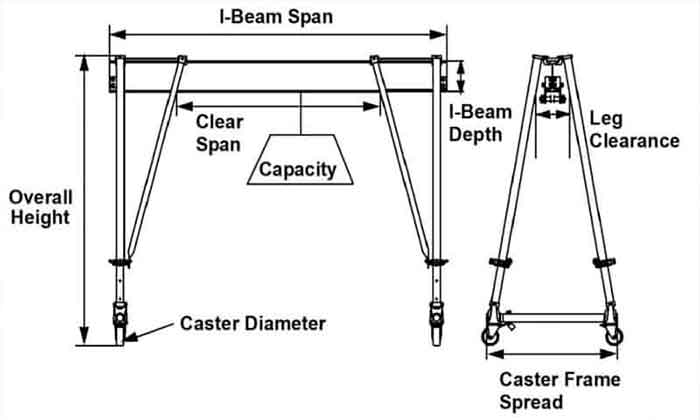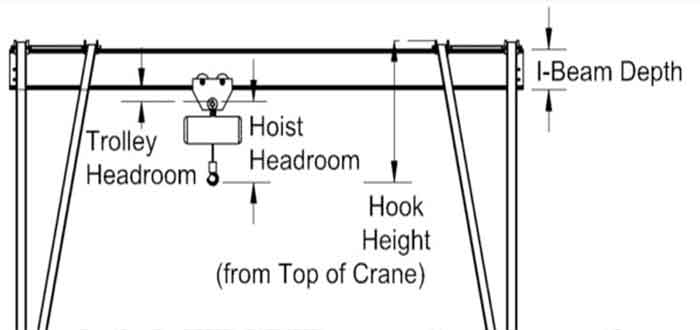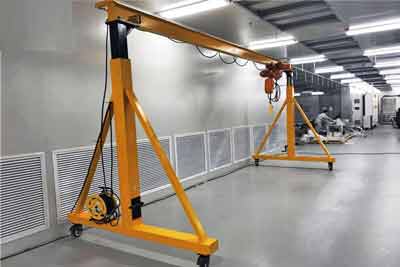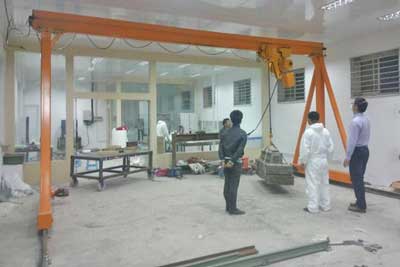What Is A Portable Gantry Crane? How To Buy A Gantry Crane?
What is portable gantry crane? How to buy a portable gantry crane for your application cost-effectively? Check our tips on portable gantry crane buying.
There are various types of gantry cranes on the market, each with its own set of benefits and applications. The portable gantry crane is perhaps the most versatile and economical one of gantry cranes.
Gantry cranes are extremely useful in a wide range of industries, and yours might benefit more from a portable crane than others.
What Is A Portable Gantry Crane?
A standard gantry crane is made up of one or two steel beams supported by steel legs and a trolley that runs between the beams. The legs rest on floor rails and can move along them, allowing the gantry to straddle a workspace or object.
Portable gantry cranes are generally of a similar but light design, but usually only have one beam, which is very easy to be disassembled and reassembled.and the gantry legs is mounted on portable rollers or castors, which make them can be easily relocated.
Because they are portable, they are smaller than most other types of gantry cranes and have a lower capacity. Most portable gantry cranes have capacities ranging from half a ton to 10 tons.
Gantry Crane Uses
Portable gantry cranes have a limited load capacity but exceptional versatility, making them useful in a variety of applications.
Construction
A gantry crane's portability from site to site is a huge benefit for the building industry. Small loads such as concrete blocks, metal beams, and timber are required on almost all construction sites, and portable gantry cranes are ideal for moving such materials.
Manufacturing Plants
There are many different types of manufacturing facilities, and as a result, various gantry crane types are used.
Gantry cranes may be used, for instance, by auto and aviation manufacturers to place or install engines.
Repair Shops
Repair shops may use gantry cranes for engine removal, just as auto manufacturers do for engine placement. Due to space restrictions, a large gantry crane is impractical in such a setting.
An engine can be removed and moved with ease using a portable gantry crane, allowing workers to access it from all sides and perform the required repairs.
Warehouses
Warehouses requires a high level of flexibility. Due to the design of most warehouses, overhead cranes are not ideal for moving loads, so they frequently employ a number of gantry cranes.
Environmental items frequently need to be lifted in a warehouse and moved to different locations, which a static gantry crane cannot do. This can be done with portable gantry cranes, which can also be disassembled when not in use to conserve space.
Advantages of a Portable Gantry Crane
Full-gantry cranes are the most frequently used gantry crane , used in dedicated areas, and double-girder gantry cranes are the largest, with lifting capacities of from 5 ton to 320 tons.
However, their size and dimensions can be a problem in some applications.
Portability
Because they are not fixed in one place dut to the roller design, portable gantry cranes have this advantage over other kinds. They are simple to move to different jobsites or factories as needed.
The portable gantries can be moved from indoors to outdoors or vice versa without needing to be disassembled because they are small enough to fit through narrow openings or doors.
These have wheels or casters instead of legs that are mounted on rails, making them suitable for any flat surface.
Adjustability
Another type is adjustable gantry cranes, which can be either fixed or portable. Portable gantry cranes are already very versatile, so having one that is adjustable adds even more versatility.
The width, height, and horizontal beam can be adjusted to meet the needs of a location or the specific load(s) being lifted.
Some are even equipped with lateral stands that can be adjusted independently. Models with this type of design can be used on uneven surfaces if necessary.
There are various tools and attachments, as with most lifting equipment. This includes casters, winches, and bumpers, etc.
Indoor/Outdoor Use
Gantry cranes can be used outside if they are made of a suitable material and are adequately protected. A steel gantry crane can be painted or finished to prevent from the rusting or corrosion .
Different Materials
Galvanized steel and stainless steel are also excellent materials for outdoor use because they resist corrosion and hold up well to UV rays, salt water, moisture, and extreme temperatures.
Additionally, an aluminum gantry crane will be more weatherproof than a typical steel one. Additionally, aluminum is significantly lighter than steel. Because of this, they are simpler to transport and can frequently be put together quickly by just two people.
However, it should be noted that aluminum is typically not as strong as steel, which means aluminum cranes cannot lift as heavy of loads.
How to buy a portable gantry crane for your application?
In the following it explains the various factors you need to consider before making your final decision in order to assist you in making the best and most affordable choice for your business and application.
We will first provide a brief explanation of crane terminology of the main specifications and an overview of our gantry models. The following six questions we ask you help us determine your precise lifting needs.
Specifications you need to confirm
When it comes to gantry cranes, there is a lot of technical terminology. In order to be able to limit your options, you must understand the terms we have defined.

- Capacity – The maximum weight that a crane is capable of supporting is its capacity.
- Caster Diameter – Depending on the load rating, a caster's outside diameter (OD) can range from 6" to 12".
- Caster Frame Spread: The crane's "base" dimensions.
- Clear Span: The separation of the brace legs (if present).
- I-Beam Depth: The height of the I-Beam, which varies depending on the span and capacity, is between 4" and 24".
- I-Beam Span - The total length of an I-beam. I-beams can be cut to fit, even though most charts show 5-foot increments.
- Leg Clearance - The distance between the legs at the I-beam. This determines whether a hoist can pass through the legs.
- Overall Height - The crane's height from the ground to the highest hook point.
Although not a comprehensive list, being aware of these fundamental specifications will assist you in finding a crane that meets your specific requirements.
Questions help you to confirm your specifications
To begin narrowing down your model options, consider the following six questions:
How heavy a load do you want to lift?
The maximum lifting capacity of the crane models available to you will be determined by the weight of the load you wish to lift.Yuantai Crane offers gantry models with capacities ranging from one-quarter to ten tons, with customized models available up to twenty tons.
How high do you want to lift the load?
Consider whether the load will have to be lifted over shop floor equipment or whether there are any overhead obstructions or ceiling restrictions, as this will reduce the amount of space available to lift a load. The portable gantry crane itself has parts and pieces that must be considered in your calculations.
Headroom Basics

- Hook to Hook Distances - Hoist Headroom
- Hook Height - The distance between the top of the crane and the hook. Subtract this distance from the Overall Crane Height to determine whether a particular crane will "fit."
- I-Beam Depth - This number cannot be changed for a given capacity and span.
- Trolley Headroom - The space between the bottom of the I-beam and the top of the hook.
When determining the required crane width or span, consider the need to lift loads over equipment. Is it necessary for the crane to move over an object, or for the object to move over the crane? If the crane must move over the object, it must be able to "span" it. The length of the i-beam determines the crane span. Yuantai Crane cranes typically span 8 to 35 feet.
Clear Span and Brace Legs
All three types of cranes have brace legs: Tri-Adjustable, Hippolift, and Mighty Mite. These legs maintain the frame's rigidity while it is in motion, adding stability in the direction of travel that is perpendicular to the I-beam.The distance between brace legs is known as the clear span.
What is the locations for the portable gantry crane?
Make sure the location is appropriate for the crane before purchasing.
Yuantai Crane can move on concrete surfaces that are flat and smooth. Although the casters are all on the floor thanks to the exclusive four-bar linkage, it should be avoided to move the crane over obstacles and debris.
Regarding the concrete flooring, there are a few things to be aware of. The flooring beneath a crane should be made of 3,000 psi (pound-force per square inch) concrete that is at least 18" deep and has one or more courses of rebar because the crane will exert a "line load" on the floor through its casters.
The standard Yuantai Crane casters, available in phenolic or steel core with polyurethane tread, are capable of smoothly moving the crane across the floor at full load with motorized travelling design.
The crane track can be mounted as an option. For these cranes, which are typically powered by an electric motor, the casters are replaced with V-groove steel wheels that run on a track (angle iron mounted on a plate). Yuantai Crane manufactures this track in-house and offers three capacities: 1-5 tons, 8-10 tons, and 15 tons. The track sections come in standard lengths of 5 and 10 feet, with male and female sections for smooth running. A Yuantai Crane Track Clip (a cast iron part) bolted to the high-strength concrete floor holds the track in place. For high traffic areas, Yuantai Crane also manufactures track with end stops and a removable transition section.
Are there any special environmental needs?
Yuantai Crane, in cooperation with hoist vendors, can provide "food-grade" hoists and trolleys for clean-room or harsh environments (chemical or outdoors). However, in many cases, standard grade equipment (which is much less expensive) is used instead of the more expensive stainless-steel equipment with stainless-steel chains. Even in harsh conditions, you can often live for several years.
One of the ironies is that a cleanroom crane is frequently used in wastewater treatment. The unpainted aluminum I-beam does not typically "shed" particulate matter in a clean room. Furthermore, the lubricants used in the hoist (and hoist chains), trolley, and casters have low outgassing.
Because of the use of corrosives such as chlorine compounds or the requirement to run cranes outside, aluminum is frequently preferred for its lightweight and weather resistance. Because our cranes are frequently shuffled between sites or within a single site where there are no continuous paths between various tanks or pump locations, weight is often an important consideration.
Are there any special power needs?
Is the hoist and trolley going to be manual or electric? What is the required voltage for an electric hoist? Higher capacity hoists (those weighing more than 2 tons) typically require three-phase power.
You may have already decided to purchase a portable gantry crane, but you must still select a model.
Yuantai Crane & Hoist offers several models, and the best one for you will depend on your requirements.
For over 34 years, we have been helping companies with their lifting solutions. We are always willing to help. If you have any questions, please feel free to contact us today.






